Start your photo travel tour with Joan Ubide, while he’s on his photographic discovery of Mongolia.
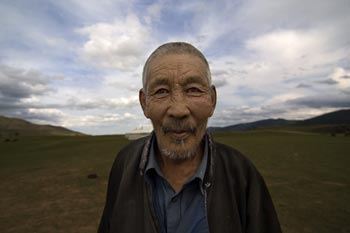
Copyright 2007 Joan Ubide
1/640 F4, iso 100, 14mm
Joan Ubide, 37 years old and born in Spain, is an example of a fan of photography who left everything he had previously thought was important to discover the world and show others that leaving was both possible and not too difficult. Ubide had been working for nineteen years non-stop inside the sales and marketing world, the kind of job that receives mail everyday. He was constantly thinking “sell more” until his love of photography finally suggested a new a life style. He had felt tied to having “everything,” but when he discovered that he truly had nothing, his first step was to sell his car, buy a good backpack, and decide to leave his life for a few months…or years. He planned to share his discoveries through the lines and shadows captured by his camera.
In June of 2007, Ubide started a trip that, to-date, has spanned several countries in Europe, Russia (via the Trans Siberian Way), and Mongolia. In this short article, he’ll share some of his experiences and a few images. At this writing, Ubide is traveling through China with a plan to visit Tibet, Nepal, India and Vietnam. He doesn’t want to stop. This is his time to learn and discover.

I started this trip four months ago, and I’m losing count of the number of trains and borders I’ve crossed, but I think I’ll never forget when I crossed the border between Russia and Mongolia. When we arrived by train, we had to wait for seven hours to get out of the country. We had been warned about the passage, even in travel guides, so we wanted to take it very easy. It’s was in those tense moments that I remembered with a smile how stressed I used to get everyday when I drove to my office in Barcelona. Being stuck in traffic for thirty minutes used to drive me nuts, and I was stuck on a train for seven hours. After our bags and passports had been checked at last, the train set off. I could see the beautiful landscapes that told me I was entering a new world–Mongolia, one of the more desirable stages of the trip.
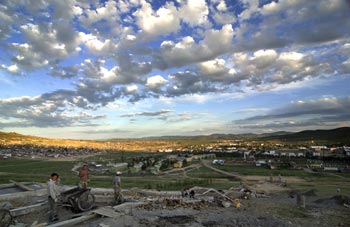
Copyright 2007 Joan Ubide
1/180 F6.3, iso 100, 12mm
However, after we reached the Mongolian side of the border, we had a minor mishap. When the border agents were about to check my passport, I looked at it and saw, stunned, that the entry date the travel agency had put on my visa was wrong. According to it, I could enter the country only four days later. What I fool I was not to check my visa! I looked at my friend Gadea and told him, “We’ve one problem, Mate.”
The lady in uniform took my passport. I was praying she wouldn’t notice, but suddenly she stared at my visa, looked me in the eye (I was acting dumb), and in Mongolian said something like, “What are you doing here, you silly thing?”
She left and returned with a very unfriendly looking guy, and told us, “Get your luggage. In five hours there’s a train back to Russia.”
I imagined myself being sent back to Russia and, once there, back to Mongolia (because we had no visa), bouncing for four days from border to border.
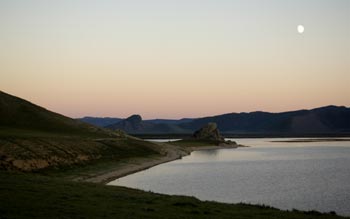
Copyright 2007 Joan Ubide
1/750, F1.8, iso 100, 50mm
So, we gathered up our bags. The people who were meeting us at the train were watching us with sorrow through the windows, making supportive gestures. We were kept waiting for three hours, without knowing what the officials would do with us. Our friend Cristian (a guy who I met in Russia) spoke to a Dutchwoman who seemingly worked at the Consulate. She acted as our mediator. Luckily, after we paid twenty dollars per head, we were allowed to re-board the train. The sad faces of our friends became all laughter and welcome greetings, as we finally managed to reach our destination. Honestly, I think the officials only wanted to frighten us, because they simply changed the date in pencil and let us go. However, I don’t think the money went to public funds. (A million thanks to the person who helped us. If you read this, I’m sorry but I lost your e-mail address. If you ever visit my country, don’t hesitate to contact me; my home will be yours.)
We arrived at Ulaanbaatar, the capital city of Mongolia. Road traffic is total chaos there, and it’s also a highly polluted city, so we quickly left for the great valleys and wild grasslands. There are several well-known routes in the country. The most popular is the southern route, where you can visit the Gobi desert. We decided to take the western route, which takes eight days. You rent an all-terrain vehicle with a driver, and you’re ready to enjoy the country.
There are several agencies that offer tours. The most popular one with the best infrastructures is Nomads, located at Peace Av. You can also find Golden Gobi, which includes a guide who speaks English and cooks for you. We decided to make the tour with UB Guest House. I strongly recommend this option if you want to live the real thing and be a nomad for a few days. On this route, you visit Kharkhorum, the great valleys, the Great White Lake, and several nomad settlements.
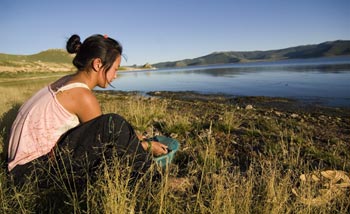
Copyright 2007 Joan Ubide
1/4000 F4,(A-0.6) iso 400, 14mm
Our driver Beijing, a 37-year-old father-of-three, was quite a character. He spoke no English at all, but we understood each other through gestures. The most common gesture was the one for eating, followed closely in frequency by the one for “Beijing, when will we get there?”
He always said, “In two hours,” while laughing his socks off. Two hours later, when we asked him again, he gestured, “One hour and a half!” and started laughing again.
If you’re going to Mongolia, forget about roads; there aren’t any. It’s all wild grasslands where you bounce up and down in your all-terrain vehicle. We drove along never-ending roads for five-to-eight hours. It was always the same: we would climb to a large grassland. From there, we could see an endless valley with another mountain at the end. Then we would go up that mountain, and again view another endless valley. We were surrounded by breathtaking landscapes and all kinds of livestock at every moment. From time to time, we would see a man riding on a horse and, if we were very lucky, another car.
We slept, lived, and ate with nomads–wonderful people. We could see that we consumerist Westerners are crazy. The nomads live happily in their gers (tents) without running water or electricity or, of course, TV with ads to make you buy as much as possible. The center of their lives is the fire in the ger, which keeps the house warm and is also the kitchen. I don’t even want to think what their lives are like in the cold season, with temperatures dipping under minus 40 degrees Celsius.
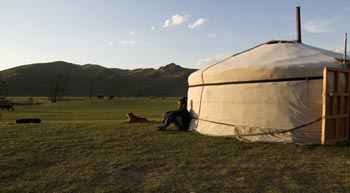
Copyright 2007 Joan Ubide
1/640 F4.5, iso 160, 15mm
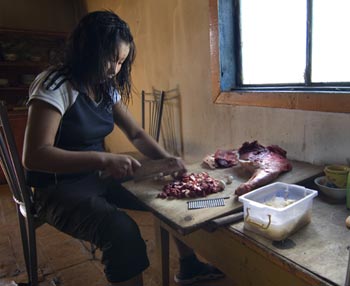
Copyright 2007 Joan Ubide
1/30 F4, iso 100, 17mm
Nomadic food is very basic. We spent eight days eating soup, which tasted strongly of livestock, and a milk tea. I didn’t like it, but it was all I had. I knew I was far from the “tapas” they serve at the restaurant Genil in Vilanova, my home town. The closest thing to a restaurant I could find was a house where a girl placed a piece of meat on the table, surrounded by flies. (You can see the picture in the album to have an idea.)
When we had to go to the toilet… well, we just had to act like the livestock and do it “al fresco.” The nomads have small wooden cottages with a hole in the ground for those who are embarrassed about squatting in the open air. Personally, I preferred acting like the livestock. And when it comes to showers, it’s pretty easy–they just don’t have them. We were lucky if we had a mirror and a washbasin, so there was only one option–a visit to the chilly river. We could also find “modern” places where they had a water barrel on the ceiling with a log fire beneath to create a five-star luxury–hot water! During those days, I caught a sort of flu or virus. (I think I caught it from Beijing; he was always coughing, so I ended up like a Mongolian, coughing and so on.)
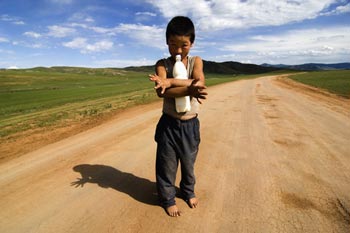
Copyright 2007 Joan Ubide
1/640 F6.3, iso 100
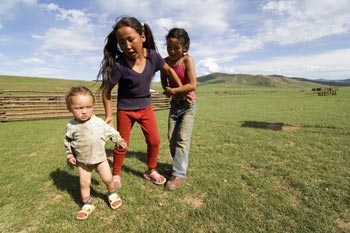
Copyright 2007 Joan Ubide
1/350 F7.1, iso 100, 12mm
Throughout my months of traveling and doing photography (we’ve been on the road nearly four months already), I’ve met amazing people, which is–without a doubt–one of the best experiences of this trip. Among the most interesting is Cristian, an Italian from Milan.
Cristian, a photography lover, travels with his old Nikon F from the 80s, a camera he bought at a second-hand market. He’s an admirable person. Only twenty-five-years old, he recently earned a degree in Biomechanical Engineering. Now he’s traveling alone for a month-and-a-half. After that, he’ll return to Milan to work in a book shop for three or four weeks before he begins looking for a job. (I predict that in less than a year, he’ll send us an e-mail saying he’s coming back with us.)

And now, I board another train, out of Mongolia. I think we’ve traveled more than 15.000 km. We’re headed for China, where I want to stay about two months, so it will be a little while before I share my next article.
See you soon and have good pics,
Joan
To see more photos on Joan’s trek through Mongolia visit…
www.joanubide.com
Visit Part 2: China
Visit Part 3: Tibet
Visit Part 4: Nepal
Visit Part 5: North India
Visit Part 6: South India
Visit Part 7: Iran
by Joan Ubide

Leave a Reply